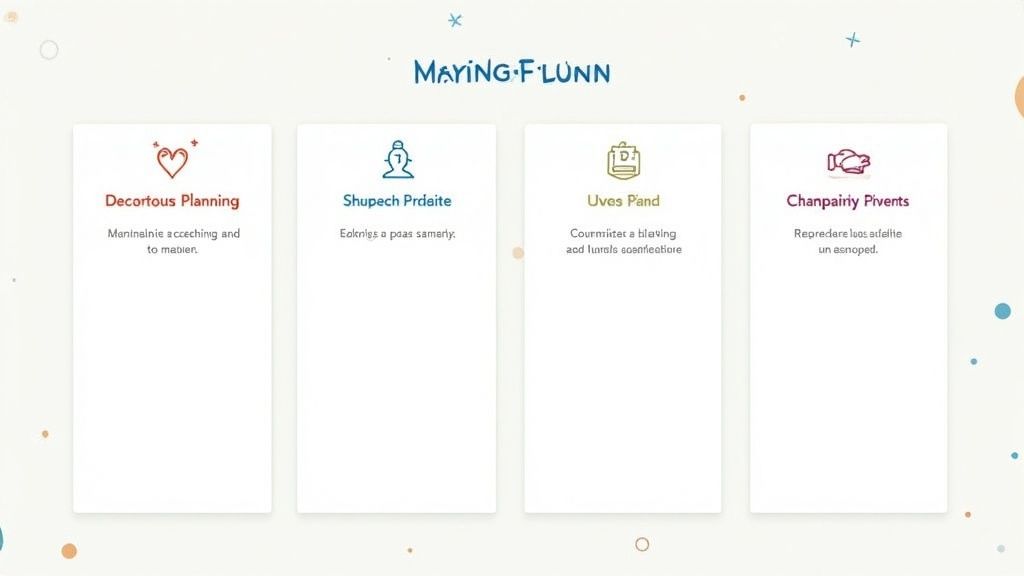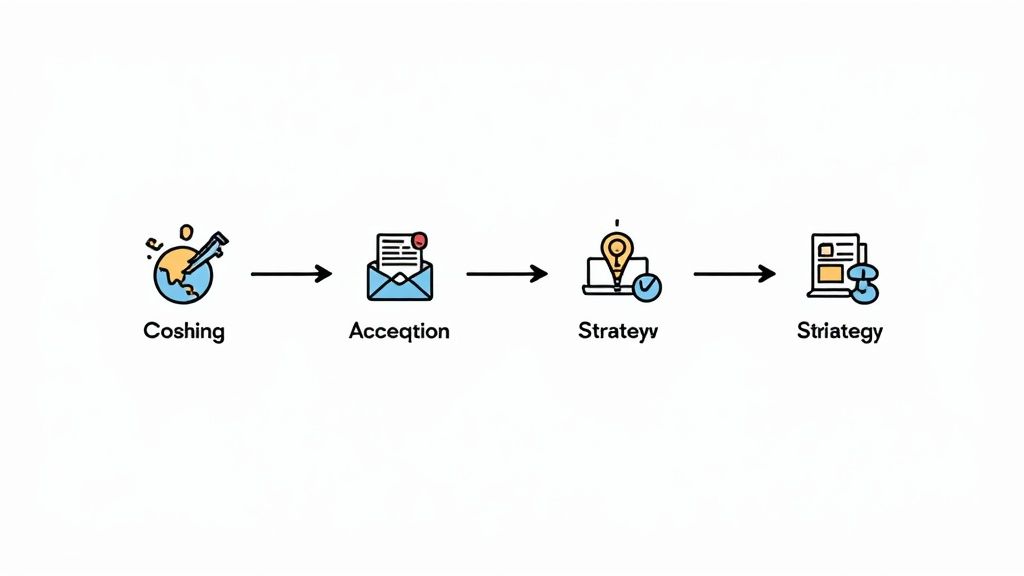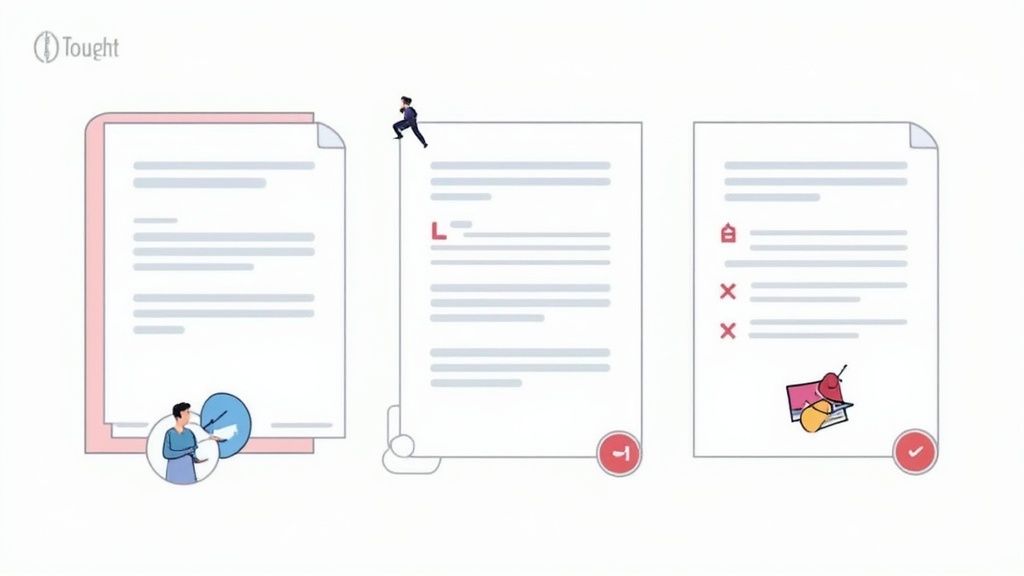Elevate Your Strategy with Our Coaching Plan Template


Why Every Coach Needs a Strategic Blueprint

Imagine trying to build a house without blueprints. It would be chaotic, wouldn't it? Similarly, coaching without a structured plan rarely delivers consistent, positive results. A well-defined coaching plan template serves as the blueprint for coaching success, offering both structure and direction. This is particularly important as the value of coaching continues to grow within the professional sphere. Coaches require a strong framework to ensure they deliver impactful results for their clients. You might be interested in: How to master your coaching skills through expert-led growth.
The Pitfalls of Inconsistent Coaching
Without a strategic blueprint, coaches often face the challenge of inconsistency. This can appear in various forms, including fluctuating session quality and difficulty in tracking client progress. Effective time management also becomes a significant hurdle. Creating a unique plan for every client, for example, consumes valuable time that could be spent on actual coaching sessions and client interaction. Ultimately, this hinders the coach's ability to provide the best possible coaching experience. A coaching plan template, however, offers a solution to these challenges.
The Power of a Coaching Plan Template
A coaching plan template provides a standardized, consistent approach across all client engagements. This allows coaches to concentrate on the individual needs of each client, adapting the template rather than building a new plan from the ground up. This streamlined approach naturally leads to improved time management, freeing the coach to focus on what truly matters: supporting meaningful client growth and transformation. In addition, templates make progress tracking significantly easier. With a clear framework and pre-defined metrics in place, coaches can monitor client development and make any necessary adjustments along the way.
Real-World Impact and ROI of Coaching Plans
Research demonstrates a strong connection between structured coaching plans and positive client outcomes. Coaching plans have become especially important in organizational settings. In fact, 87% of professionals recognize that executive coaching offers a substantial return on investment (ROI), boosting productivity and increasing employee motivation. This highlights the effectiveness of structured coaching in achieving business objectives. In the UK, organizations embracing coaching cultures frequently observe higher employee engagement, with 72% noting a correlation between well-designed coaching plans and increased engagement levels. Find more detailed statistics here. The use of coaching plan templates improves this process, ensuring consistency and efficiency across different teams and departments. By providing a clear structure, these templates empower managers to have meaningful interactions with their employees, saving them time and effort that would otherwise be spent building plans from scratch. This underscores the value of integrating a coaching plan template into any coaching practice.
Essential Elements That Make Coaching Plans Powerful

A powerful coaching plan isn't just a static document. It's a dynamic roadmap that guides the entire coaching process. Creating an effective coaching plan template requires careful consideration of several key elements. These elements work together to build a framework that empowers both the coach and the client to achieve real progress.
Goal-Setting Frameworks: The Foundation of Success
Any robust coaching plan begins with clearly defined goals. These goals should adhere to the SMART framework: Specific, Measurable, Achievable, Relevant, and Time-bound. Vague goals like "improve communication skills" lack the clarity needed for effective coaching. A SMART goal, such as "deliver a presentation to 10 colleagues within two months, receiving positive feedback on clarity and engagement," provides a measurable target and allows for accurate progress tracking.
This specificity sets the stage for actionable steps and keeps the focus on tangible outcomes.
Actionable Steps: Bridging the Gap Between Goals and Reality
Once clear goals are set, outlining actionable steps is critical. These steps break down larger goals into smaller, more manageable tasks. This approach makes the overall objective less intimidating and provides a clear path forward.
For example, if the goal is to write a book, actionable steps might include creating a chapter outline, setting daily writing goals, and scheduling regular editing sessions. This step-by-step approach maintains momentum and keeps the client motivated throughout the process.
Realistic Timelines: Maintaining Momentum Without Overwhelm
Setting realistic timelines is vital for sustained progress and preventing burnout. Deadlines should be challenging yet attainable, taking into account the client's other commitments and resources. Setting unrealistic timelines often leads to discouragement and can derail the entire coaching process.
For instance, setting a goal of fluency in a new language within three months may be overly ambitious. A more reasonable approach might focus on basic conversational proficiency within that timeframe. This balanced approach encourages consistent progress without undue pressure.
Feedback Mechanisms: Fueling Continuous Improvement
Regular feedback is the engine of continuous improvement. A good coaching plan should incorporate opportunities for both the coach and client to provide and receive constructive feedback. This two-way communication ensures the plan remains relevant and adapts to the client's changing needs.
Open communication also strengthens the coaching relationship and fosters a collaborative approach to growth. Effective feedback mechanisms are essential for maximizing the impact of the coaching process.
To help illustrate the core components of a successful coaching plan, the table below provides further detail and practical tips.
Introducing the table: The following table outlines the key elements every coaching plan template should include, providing explanations of their purpose and effective implementation.
| Component | Purpose | Implementation Tips | Common Mistakes to Avoid |
|---|---|---|---|
| Goal-Setting Framework | Establish clear, measurable objectives. | Use the SMART framework (Specific, Measurable, Achievable, Relevant, Time-bound). Involve the client in the goal-setting process. | Setting vague or unrealistic goals. Not aligning goals with the client's values and aspirations. |
| Actionable Steps | Break down goals into smaller, manageable tasks. | Create a detailed action plan with specific deadlines. Prioritize tasks based on their importance and impact. | Overcomplicating the action plan with too many steps. Not providing enough guidance on how to complete each step. |
| Realistic Timelines | Ensure deadlines are challenging yet attainable. | Consider the client's other commitments and available resources. Build in buffer time for unexpected delays. | Setting overly ambitious deadlines that lead to burnout. Not adjusting timelines when circumstances change. |
| Feedback Mechanisms | Facilitate continuous improvement and open communication. | Schedule regular feedback sessions. Encourage both the coach and client to provide and receive feedback. | Providing feedback that is not specific or actionable. Not creating a safe space for open and honest communication. |
| Measurement Criteria | Track progress and demonstrate the value of coaching. | Identify key performance indicators (KPIs) that align with the client's goals. Regularly monitor and evaluate progress. | Focusing on the wrong metrics. Not using data to inform coaching decisions. |
Key takeaways from the table: By incorporating these essential components, coaching plans become powerful tools for driving meaningful change and achieving lasting results. Remember, a well-structured plan helps ensure both the coach and client are on the same page, working collaboratively towards clearly defined objectives.
Measurement Criteria: Tracking Meaningful Progress
Finally, a strong coaching plan should include clear measurement criteria to effectively track progress. These metrics should go beyond superficial assessments and focus on significant changes in behavior, skills, or performance. Focusing solely on surface-level metrics may not accurately reflect the real impact of coaching.
For example, tracking the number of new professional connections established, rather than just the number of networking events attended, provides a more meaningful measure of progress. This emphasis on tangible outcomes ensures the coaching process delivers real value. Employee coaching plans are vital for personal and professional development. Using a coaching plan template ensures consistency and fairness, especially in larger organizations. Learn more about employee coaching plans. This focus on tangible outcomes demonstrates a clear return on investment.
Customizing Your Coaching Plan Template for Real Impact

Effective coaching isn't one-size-fits-all. A coaching plan template provides a solid foundation, but its true strength lies in its adaptability. Successful coaches know the importance of customizing templates to fit different situations and individual client needs. This maximizes the impact of their coaching practice. It's about tailoring the approach while keeping the template's core structure.
Adapting Your Template: Different Coaching Scenarios
A good coaching plan template should be versatile enough to handle a range of coaching scenarios. For executive coaching, the focus might be leadership development and strategic thinking.
However, for team development, the template might emphasize communication, collaboration, and resolving conflict. A performance improvement plan centers on specific metrics and steps for enhancement. A career advancement plan will focus on skill development, networking, and long-term career goals. Each scenario needs a unique approach, highlighting the need for a flexible template.
Considering Context: Industries, Cultures, and Learning Styles
Customizing your template goes beyond the type of coaching. You also need to consider the specific context of each client. Different industries have unique challenges and opportunities.
Organizational cultures influence communication styles and expectations. Individual learning styles are also important. Some clients prefer structured environments with clear directions, while others prefer a more flexible approach. A skilled coach adjusts their template to these nuances, creating a personalized experience.
Practical Modifications for Maximum Impact
How do you effectively customize your coaching plan template? One strategy is modifying the delivery methods. Some clients may prefer in-person sessions, while others might prefer virtual coaching or a blended approach.
Measurement criteria should align with each engagement's specific goals. Adjust engagement approaches to maintain client motivation. This could involve different learning activities, resources, or communication styles. Diversity and inclusion are crucial in coaching. In the UK, the UK Coaching Diversity and Inclusion Action Plan (DIAP) addresses these concerns by incorporating equity, equality, diversity, and inclusion (EEDI) principles. Learn more about diversity and inclusion in coaching. Read the full research here.
Maintaining Structural Integrity While Customizing
While customization is key, maintaining the template's structural integrity is crucial. The core components—goal setting, action steps, timelines, and feedback—should remain consistent. This provides a reliable framework for both coach and client, keeping the coaching process focused and effective. You might be interested in learning more about effective coaching frameworks. How to master your coaching sessions with proven frameworks.
By balancing customization and structure, you create a versatile coaching toolkit that delivers consistent results. This strengthens the coaching relationship and empowers clients to achieve their goals.
Bringing Your Coaching Plan Template To Life

A coaching plan template isn't just a static document. It's a dynamic tool designed to facilitate client transformation. Truly effective coaches understand that using a template successfully means blending its structure with the flexibility of human interaction. This section explores the practical steps to effectively implement your coaching plan template.
Initial Assessment: Uncovering Client Needs
The first step involves a thorough initial assessment. This goes beyond gathering basic information. It's about truly understanding the client's needs, aspirations, and the challenges they face. Skilled coaches use various techniques, like open-ended questions and active listening, to uncover the root issues the client hopes to address. This groundwork is essential for creating a focused and effective coaching plan.
Building Rapport: The Foundation Of Trust
A strong coaching relationship rests on a foundation of trust and mutual respect. Building rapport with your client is critical to creating a safe and supportive space where open and honest communication can thrive. This means demonstrating empathy, practicing active listening, and showing genuine care for the client's well-being.
Maintaining professional boundaries is equally vital. This ensures the coaching relationship stays focused on achieving the client’s stated goals. This balance of warmth and professionalism creates an environment conducive to growth.
Conducting Effective Coaching Sessions: Staying Focused And Flexible
Structure your coaching sessions around the objectives laid out in the coaching plan template. This provides a clear roadmap for each meeting and ensures progress toward the client’s goals. However, flexibility is just as important. Clients may encounter unexpected obstacles or discover new areas they want to explore.
A skilled coach adapts the session to address these emerging issues while staying aligned with the overarching coaching plan. This blend of structure and flexibility ensures the coaching process remains relevant and responsive.
Maintaining Momentum Between Meetings: Accountability Without Micromanagement
Consistent progress relies on maintaining momentum between coaching sessions. This involves clear communication and agreed-upon action steps for the client. Regular check-ins and follow-up can ensure accountability without being overbearing. Encourage clients to reflect on their progress and identify potential roadblocks to keep them engaged and motivated. This proactive approach fosters ownership of their growth.
Navigating Roadblocks: Overcoming Challenges To Progress
Clients will inevitably face challenges and setbacks during their coaching journey. A skilled coach anticipates potential roadblocks and develops strategies to help clients navigate these hurdles. This could involve reframing limiting beliefs, developing new coping mechanisms, or adjusting the coaching plan itself. Providing support and encouragement during these difficult times builds client resilience.
Real-World Examples: Learning From Seasoned Coaches
Learning from experienced coaches offers invaluable practical insights. Observing how seasoned professionals conduct assessments, build rapport, and handle challenging situations provides a wealth of knowledge. Analyzing real-world coaching scenarios and their outcomes can help you develop a roadmap for turning your template into a living, breathing framework.
Many coaches find value in planning in shorter “mini-seasons” of 6-8 weeks to align their plans with natural cycles and school holidays. While personal schedules are a factor, prioritize the individual needs of your client and the overall structure of your coaching plan. This personalized approach drives measurable change and leads to lasting client success.
Measuring What Matters: Coaching ROI and Impact
Client satisfaction is important in coaching. But how do we truly measure the efficacy of a coaching plan template? This is where understanding Return on Investment (ROI) and impactful evaluation becomes essential. Data-driven coaches know that demonstrating tangible results is vital for both client satisfaction and business growth. This requires looking beyond simple satisfaction surveys.
Beyond Surface-Level Satisfaction
While client satisfaction surveys offer valuable feedback, they only present a partial view. A truly comprehensive evaluation should encompass both quantitative results, such as improved key performance indicators (KPIs), and qualitative transformations, such as increased confidence and improved communication skills. For instance, tracking a client's sales growth after coaching provides concrete data.
Complementing this with observations about how their communication style has become more assertive gives a more holistic understanding of the coaching's impact. This multifaceted approach provides a much richer picture of a client’s development.
Practical Methods for Measuring Impact
There are various methods for capturing the complete impact of coaching. Performance indicators, linked to specific goals outlined in the coaching plan template, offer a clear measure of progress. Behavioral assessments can highlight shifts in mindset and habits. Collecting stakeholder feedback provides valuable external perspectives on a client’s progress.
Don't underestimate the value of self-reflection, either. Providing clients with frameworks for self-assessment empowers them to track their own growth and understand the value they've gained from the coaching process.
To understand coaching effectiveness, proper evaluation is crucial. Planning these methods early in the coaching process ensures that the intended benefits are achieved. Learn more about evaluating coaching program effectiveness here. This proactive approach sets the stage for meaningful results.
Designing an Effective Evaluation System
A successful evaluation system should align directly with the coaching objectives defined in the coaching plan template. This ensures that the data collected is both relevant and insightful. Gathering data at different stages of the coaching process provides ongoing insights into a client’s progress. This also allows for adjustments to the coaching plan as needed.
Clearly communicating these results to clients is key to demonstrating the value of the coaching engagement. This might involve creating reports that summarize key achievements or sharing client testimonials. You might be interested in: How to Measure Coaching Effectiveness. This transparency strengthens the coach-client relationship.
Many coaches find that structuring their plans into shorter “mini-seasons” of six to eight weeks enhances their focus on evaluation and goal setting. This approach allows for shorter, more manageable assessment cycles. As a result, the coaching plan becomes more responsive to the client's progress.
To provide further clarity on different evaluation methods, the table below summarizes key characteristics:
Introduction to table: The following table provides a comparison of different evaluation methods used in coaching programs, highlighting their strengths, limitations, and ideal applications.
| Evaluation Method | Best For | Key Metrics | Implementation Complexity | Reliability |
|---|---|---|---|---|
| Client Satisfaction Surveys | Gauging overall satisfaction | Satisfaction scores, feedback comments | Low | Moderate (can be subjective) |
| Performance Indicators | Measuring progress towards specific goals | KPIs, quantifiable outcomes | Moderate | High (data-driven) |
| Behavioral Assessments | Identifying shifts in mindset and habits | Behavioral changes, personality assessments | Moderate | High (standardized tools) |
| Stakeholder Feedback | Gathering external perspectives | 360-degree feedback, peer reviews | Moderate to High (requires coordination) | Moderate (potential for bias) |
| Self-Assessments | Fostering client self-reflection | Self-reported progress, journal entries | Low | Moderate (relies on client honesty) |
Conclusion of table: Each evaluation method offers unique insights into the effectiveness of a coaching program. Using a combination of these methods provides a more holistic understanding of client progress and overall coaching ROI.
Refining Your Coaching Plan Template
Effective coaches leverage evaluation data to continuously refine their coaching plan templates. By analyzing successful strategies and identifying areas for improvement, they ensure their templates remain effective and relevant. This iterative approach leads to improved client outcomes and enhances the coach's professional reputation. This commitment to continuous improvement is a hallmark of successful coaching practices.
Future-Proofing Your Coaching Plan Template
The coaching world is constantly changing. Are your methods keeping up? Forward-thinking coaches are using new technologies and approaches to improve their practice and meet the increasing demands of their clients. This means integrating new ideas while keeping the core human element that makes coaching so effective.
Embracing Technological Advancements
Technology is reshaping the coaching experience. AI-assisted coaching tools, like those from BetterUp, can provide personalized insights and feedback, improving the coaching process. Digital progress tracking platforms streamline monitoring and reporting, making it easier to show value and adjust strategies when needed. These tools aren't meant to replace the coach, but to enhance their abilities and free up time for more meaningful client interaction.
For example, AI can analyze client communication patterns to find areas for improvement. Progress tracking platforms, such as CoachAccountable, can automate data collection and visualization, saving coaches valuable time. This allows coaches to focus on what they do best: building relationships and helping clients reach their goals.
The Rise of Hybrid Coaching Models
Hybrid coaching models, which combine in-person and virtual sessions, are becoming more and more common. This offers greater flexibility and accessibility, letting coaches reach a wider audience and cater to different client preferences. This adaptability is important, as clients now expect personalized and convenient solutions.
Hybrid models can also incorporate different learning resources and technologies. This enriches the coaching experience and gives clients more tools for success. This combined approach creates a more engaging and effective coaching journey. The UK's Coaching Plan for England provides valuable insights into evolving coaching practices. It aims to modernize coaching by addressing challenges like training accessibility and coaching qualification formats. Learn more about the Coaching Plan for England.
Personalization and Data-Driven Approaches
Clients increasingly want personalized coaching experiences. By using data from assessments, progress tracking platforms, and client feedback, coaches can adapt their templates and approaches to individual needs. This data-driven approach makes coaching more effective and ensures clients receive the support they need. This focus on individualization strengthens the coach-client relationship and leads to better results.
Maintaining the Human Connection
While technology is playing a bigger role, human connection is still at the heart of effective coaching. Empathy, active listening, and building rapport are essential skills that can't be replaced by algorithms. This emphasis on the human element is what makes coaching special and drives meaningful change.
Adaptive Coaching: Staying Ahead of the Curve
The coaching field is always evolving. To stay on top, coaches need a mindset of continuous learning and adaptation. This means staying updated on new research, exploring new trends, and being open to trying new approaches. Many coaches are using a "mini-season" planning approach, focusing on 6-8 week cycles to better align their plans with personal schedules and natural rhythms. This allows for quicker adjustments and keeps the coaching plan relevant and impactful.
By using these strategies, coaches can future-proof their templates and set themselves up for continued success in the dynamic world of coaching. This forward-thinking approach helps them meet the changing needs of their clients and remain leaders in their field. Ready to improve your coaching practice and create truly transformative experiences for your clients? Visit Coaching Hub today to find valuable resources, insights, and tools to help you become a more effective and impactful coach.